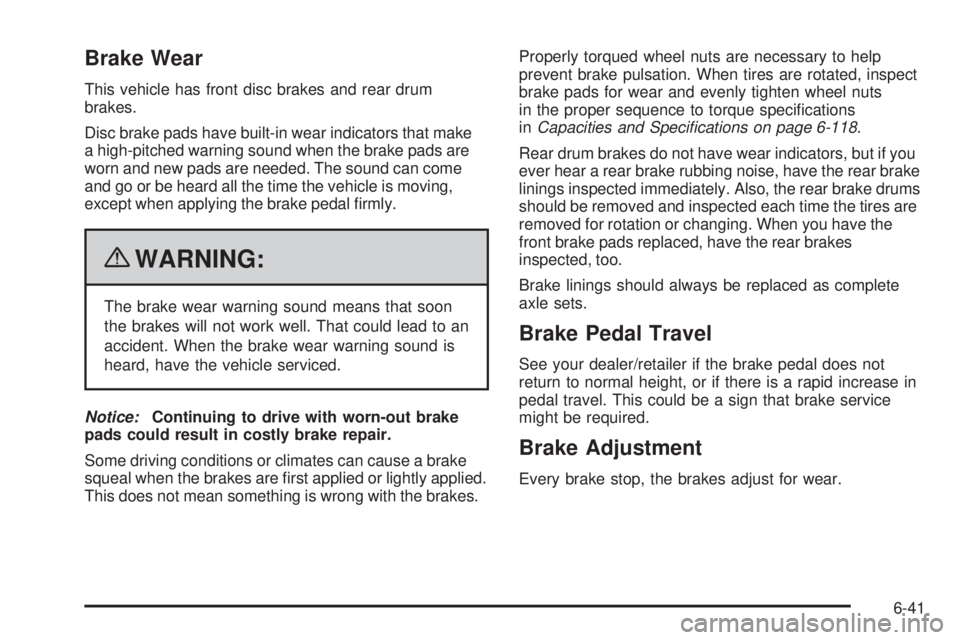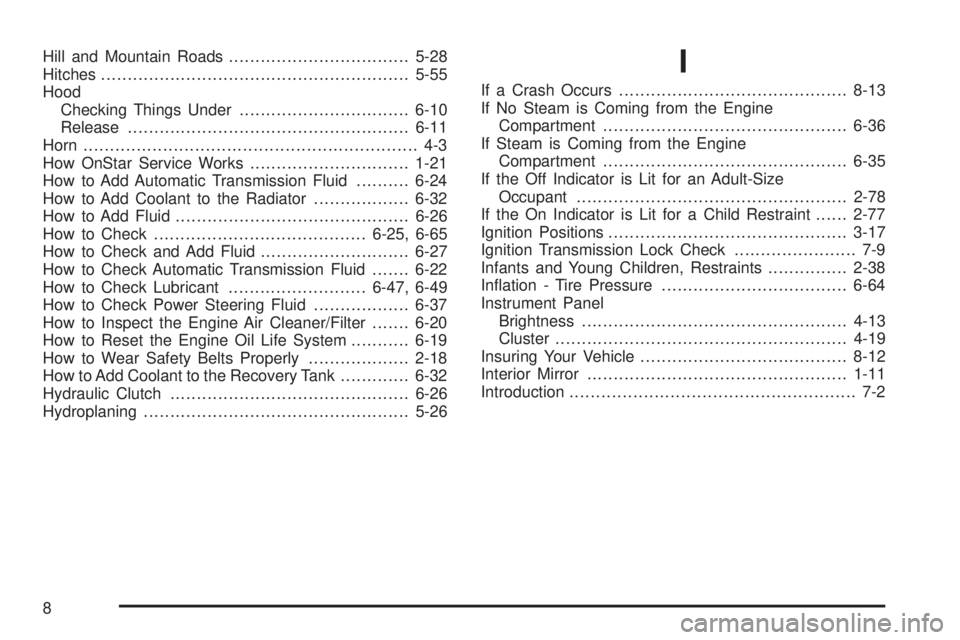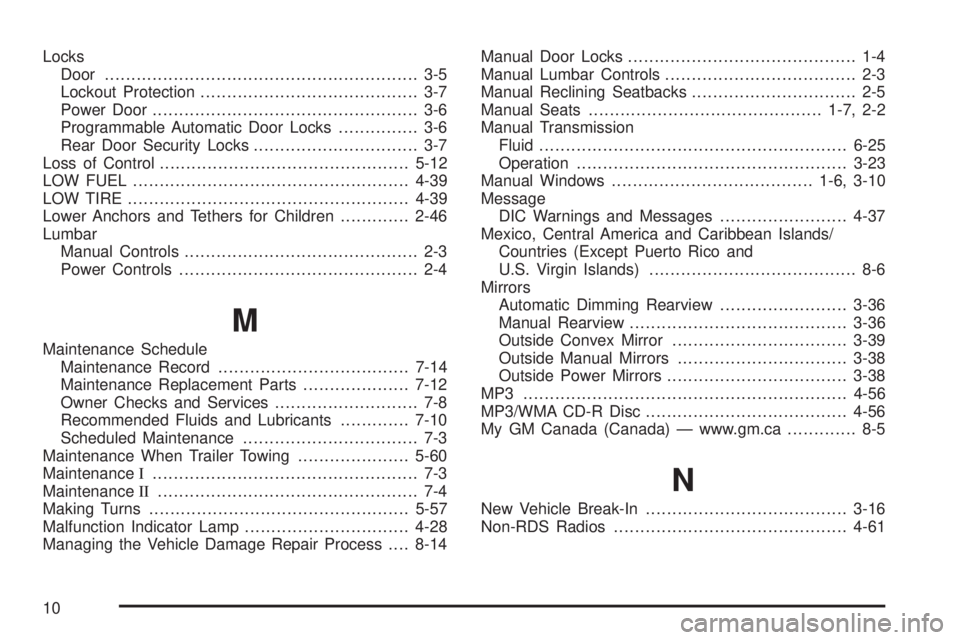2010 GMC CANYON service indicator
[x] Cancel search: service indicatorPage 178 of 448

Antilock Brake System (ABS)
Warning Light
The Antilock Brake
System (ABS) light
comes on briefly when
the engine is started.
If it does not, have the vehicle serviced by your
dealer/retailer. If the system is working normally the
indicator light then goes off.
If the ABS light stays on, turn the ignition off. If the light
comes on while driving, stop as soon as it is safely
possible and turn the ignition off. Then start the engine
again to reset the system. If the ABS light stays on, or
comes on again while driving, the vehicle needs service.
If the regular brake system warning light is not on, the
vehicle still has brakes, but not antilock brakes. If the
regular brake system warning light is also on, the vehicle
does not have antilock brakes and there is a problem with
the regular brakes. SeeBrake System Warning Light on
page 4-25.
SeeDIC Warnings and Messages on page 4-37for all
brake related DIC messages.
StabiliTrak®/Traction Control
System (TCS) Warning Light
The StabiliTrak and
Traction Control System
(TCS) indicator/warning
light comes on briefly while
starting the engine.
If it does not, have the vehicle serviced by your
dealer/retailer. If the system is working normally
the indicator light then goes off.
The light flashes while the StabiliTrak system and TCS
are working to assist the driver with directional control
of the vehicle in difficult driving conditions.
4-26
Page 180 of 448

Tire Pressure Light
For vehicles with a tire pressure monitoring system,
this light comes on briefly when the engine is started.
It provides information about tire pressures and the
Tire Pressure Monitoring System.
When the Light is On Steady
This indicates that one or more of the tires are
significantly underinflated.
A tire pressure message in the Driver Information
Center (DIC), can accompany the light. SeeDriver
Information Center (DIC) on page 4-33for more
information. Stop and check the tires as soon as
it is safe to do so. If underinflated, inflate to the proper
pressure. SeeIn�ation - Tire Pressure on page 6-64
for more information.
When the Light Flashes First and Then is
On Steady
This indicates that there may be a problem with the Tire
Pressure Monitor System. The light flashes for about a
minute and stays on steady for the remainder of the
ignition cycle. This sequence repeats with every ignition
cycle. SeeTire Pressure Monitor Operation on page 6-67
for more information.
Malfunction Indicator Lamp
Check Engine Light
A computer system called OBD II (On-Board
Diagnostics-Second Generation) monitors operation
of the fuel, ignition, and emission control systems.
It ensures that emissions are at acceptable levels
for the life of the vehicle, helping to produce a cleaner
environment.
This light should come on
when the ignition is on, but
the engine is not running,
as a check to show it
is working. If it does not,
have the vehicle serviced
by your dealer/retailer.
4-28
Page 183 of 448

Emissions Inspection and Maintenance
Programs
Some state/provincial and local governments have or
might begin programs to inspect the emission control
equipment on the vehicle. Failure to pass this inspection
could prevent getting a vehicle registration.
Here are some things to know to help the vehicle pass
an inspection:
•The vehicle will not pass this inspection if the check
engine light is on with the engine running, or if the
key is in ON/RUN and the light is not on.
•The vehicle will not pass this inspection if the OBD II
(on-board diagnostic) system determines that critical
emission control systems have not been completely
diagnosed by the system. The vehicle would be
considered not ready for inspection. This can happen
if the battery has recently been replaced or if the
battery has run down. The diagnostic system is
designed to evaluate critical emission control
systems during normal driving. This can take several
days of routine driving. If this has been done and the
vehicle still does not pass the inspection for lack of
OBD II system readiness, your dealer/retailer can
prepare the vehicle for inspection.
Oil Pressure Light
{WARNING:
Do not keep driving if the oil pressure is low.
The engine can become so hot that it catches fire.
Someone could be burned. Check the oil as soon
as possible and have the vehicle serviced.
Notice:Lack of proper engine oil maintenance
can damage the engine. The repairs would not be
covered by the vehicle warranty. Always follow
the maintenance schedule in this manual for
changing engine oil.
This light comes on briefly while starting the engine.
If it does not, have the vehicle serviced by your dealer/
retailer. If the system is working normally the indicator
light then goes off.
4-31
Page 283 of 448

Also, your dealer/retailer has additives that will help
correct and prevent most deposit-related problems.
Gasolines containing oxygenates, such as ethers and
ethanol, and reformulated gasolines might be available in
your area. We recommend that you use these gasolines,
if they comply with the specifications described earlier.
However, E85 (85% ethanol) and other fuels containing
more than 10% ethanol must not be used in vehicles that
were not designed for those fuels.
Notice:This vehicle was not designed for fuel
that contains methanol. Do not use fuel containing
methanol. It can corrode metal parts in the fuel
system and also damage plastic and rubber parts.
That damage would not be covered under the
vehicle warranty.
Some gasolines that are not reformulated for low
emissions can contain an octane-enhancing additive
called methylcyclopentadienyl manganese tricarbonyl(MMT); ask the attendant where you buy gasoline
whether the fuel contains MMT. We recommend
against the use of such gasolines. Fuels containing
MMT can reduce the life of spark plugs and the
performance of the emission control system could be
affected. The malfunction indicator lamp might turn on.
If this occurs, return to your dealer/retailer for service.
Fuels in Foreign Countries
If you plan on driving in another country outside the
United States or Canada, the proper fuel might be hard
to find. Never use leaded gasoline or any other fuel not
recommended in the previous text on fuel. Costly repairs
caused by use of improper fuel would not be covered by
the vehicle warranty.
To check the fuel availability, ask an auto club, or
contact a major oil company that does business in
the country where you will be driving.
6-7
Page 317 of 448

Brake Wear
This vehicle has front disc brakes and rear drum
brakes.
Disc brake pads have built-in wear indicators that make
a high-pitched warning sound when the brake pads are
worn and new pads are needed. The sound can come
and go or be heard all the time the vehicle is moving,
except when applying the brake pedal firmly.
{WARNING:
The brake wear warning sound means that soon
the brakes will not work well. That could lead to an
accident. When the brake wear warning sound is
heard, have the vehicle serviced.
Notice:Continuing to drive with worn-out brake
pads could result in costly brake repair.
Some driving conditions or climates can cause a brake
squeal when the brakes are first applied or lightly applied.
This does not mean something is wrong with the brakes.Properly torqued wheel nuts are necessary to help
prevent brake pulsation. When tires are rotated, inspect
brake pads for wear and evenly tighten wheel nuts
in the proper sequence to torque specifications
inCapacities and Speci�cations on page 6-118.
Rear drum brakes do not have wear indicators, but if you
ever hear a rear brake rubbing noise, have the rear brake
linings inspected immediately. Also, the rear brake drums
should be removed and inspected each time the tires are
removed for rotation or changing. When you have the
front brake pads replaced, have the rear brakes
inspected, too.
Brake linings should always be replaced as complete
axle sets.
Brake Pedal Travel
See your dealer/retailer if the brake pedal does not
return to normal height, or if there is a rapid increase in
pedal travel. This could be a sign that brake service
might be required.
Brake Adjustment
Every brake stop, the brakes adjust for wear.
6-41
Page 431 of 448

A
ABS (Antilock Brake System) FAULT.................4-37
AC (Air Conditioning) OFF...............................4-37
Accessories and Modifications............................ 6-3
Accessory Power............................................3-18
Accessory Power Outlets.................................4-15
Adding Washer Fluid.......................................6-38
Additional Factors Affecting System Operation.....2-78
Additional Program Information.........................8-11
Additional Required Services.............................. 7-5
Additives, Fuel................................................. 6-6
Add-On Electrical Equipment...........................6-111
Add-On Equipment..........................................5-40
Adjusting the Speakers (Balance/Fade)..............4-48
Adjustment
Chime Level...............................................4-63
Adjustments
Headlamp Range.......................................... 2-8
After Off-Road Driving.....................................5-24
Air Cleaner/Filter, Engine.................................6-20
Air Conditioning..............................................4-16
Airbag
Adding Equipment to Your Airbag-Equipped
Vehicle...................................................2-80Airbag System
How Does an Airbag Restrain?......................2-71
Passenger Sensing System...........................2-73
Servicing Your Airbag-Equipped Vehicle..........2-79
What Makes an Airbag Inflate?......................2-71
What Will You See After an Airbag Inflates?....2-72
When Should an Airbag Inflate?....................2-69
Where Are the Airbags?...............................2-67
Airbags.........................................................2-81
Passenger Status Indicator...........................4-23
Readiness Light..........................................4-22
System Check.............................................2-64
All Overseas Locations...................................... 8-6
AM ...............................................................4-62
AM-FM Radio.................................................4-43
Antenna
Fixed Mast.................................................
4-63
Antenna, XM™ Satellite Radio Antenna System.....4-63
Antilock Brake System (ABS)............................. 5-5
Warning Light.............................................4-26
Appearance Care
Aluminum or Chrome-Plated Wheels.............6-108
Care of Safety Belts...................................6-105
Chemical Paint Spotting..............................6-109
Cleaning Exterior Lamps/Lenses..................6-106
Fabric/Carpet............................................6-103
Finish Care...............................................6-107
1
Page 438 of 448

Hill and Mountain Roads..................................5-28
Hitches..........................................................5-55
Hood
Checking Things Under................................6-10
Release.....................................................6-11
Horn ............................................................... 4-3
How OnStar Service Works..............................1-21
How to Add Automatic Transmission Fluid..........6-24
How to Add Coolant to the Radiator..................6-32
How to Add Fluid............................................6-26
How to Check........................................6-25, 6-65
How to Check and Add Fluid............................6-27
How to Check Automatic Transmission Fluid.......6-22
How to Check Lubricant..........................6-47, 6-49
How to Check Power Steering Fluid..................6-37
How to Inspect the Engine Air Cleaner/Filter.......6-20
How to Reset the Engine Oil Life System...........6-19
How to Wear Safety Belts Properly...................2-18
How to Add Coolant to the Recovery Tank.............6-32
Hydraulic Clutch.............................................6-26
Hydroplaning..................................................5-26I
If a Crash Occurs...........................................8-13
If No Steam is Coming from the Engine
Compartment..............................................6-36
If Steam is Coming from the Engine
Compartment..............................................6-35
If the Off Indicator is Lit for an Adult-Size
Occupant...................................................2-78
If the On Indicator is Lit for a Child Restraint......2-77
Ignition Positions.............................................3-17
Ignition Transmission Lock Check....................... 7-9
Infants and Young Children, Restraints...............2-38
Inflation - Tire Pressure...................................6-64
Instrument Panel
Brightness..................................................4-13
Cluster.......................................................4-19
Insuring Your Vehicle.......................................8-12
Interior Mirror.................................................1-11
Introduction...................................................... 7-2
8
Page 440 of 448

Locks
Door ........................................................... 3-5
Lockout Protection......................................... 3-7
Power Door .................................................. 3-6
Programmable Automatic Door Locks............... 3-6
Rear Door Security Locks............................... 3-7
Loss of Control...............................................5-12
LOW FUEL ....................................................4-39
LOW TIRE .....................................................4-39
Lower Anchors and Tethers for Children.............2-46
Lumbar
Manual Controls............................................ 2-3
Power Controls............................................. 2-4
M
Maintenance Schedule
Maintenance Record....................................7-14
Maintenance Replacement Parts....................7-12
Owner Checks and Services........................... 7-8
Recommended Fluids and Lubricants.............7-10
Scheduled Maintenance................................. 7-3
Maintenance When Trailer Towing.....................5-60
MaintenanceI.................................................. 7-3
MaintenanceII................................................. 7-4
Making Turns.................................................5-57
Malfunction Indicator Lamp...............................4-28
Managing the Vehicle Damage Repair Process....8-14Manual Door Locks........................................... 1-4
Manual Lumbar Controls.................................... 2-3
Manual Reclining Seatbacks............................... 2-5
Manual Seats............................................1-7, 2-2
Manual Transmission
Fluid..........................................................6-25
Operation...................................................3-23
Manual Windows......................................1-6, 3-10
Message
DIC Warnings and Messages........................4-37
Mexico, Central America and Caribbean Islands/
Countries (Except Puerto Rico and
U.S. Virgin Islands)....................................... 8-6
Mirrors
Automatic Dimming Rearview........................3-36
Manual Rearview.........................................3-36
Outside Convex Mirror.................................3-39
Outside Manual Mirrors................................3-38
Outside Power Mirrors..................................3-38
MP3 .............................................................4-56
MP3/WMA CD-R Disc ......................................4-56
My GM Canada (Canada) — www.gm.ca............. 8-5
N
New Vehicle Break-In......................................3-16
Non-RDS Radios............................................4-61
10